Have you ever craved sisig but felt overwhelmed by the traditional recipe that needs a whole pig's face and hours of prep? I was in the same boat until I discovered this game-changing beef version in my own kitchen.
Here's the thing: I wanted that addictive sisig taste without the hassle, and this recipe delivered exactly that. Think tender, juicy beef chunks with that perfect sisig tang, but here's the twist – you can make it with ingredients from any grocery store, and it takes just a fraction of the time.
Cultural Notes
Sisig originated in Pampanga, Philippines, traditionally made with pig's face and liver. This beef version offers a modern, accessible take on the beloved dish while maintaining its essential flavors and characteristics.
Jump to:

Why You'll Love This Recipe
- Easier Alternative: Skip the tedious process of traditional sisig while maintaining authentic flavors
- Family-Friendly: Less spicy than traditional versions but customizable heat levels
- Budget-Conscious: Uses accessible ingredients from regular supermarkets
- Make-Ahead Friendly: Can be prepared in advance for parties
- Versatile: Works great as pulutan (beer companion) or main dish
Ingredients
This recipe uses beef sirloin for its tenderness and rich flavor, paired with liver spread to recreate the authentic sisig taste without pig face. The combination of aromatic garlic and onions creates a savory base, while calamansi (or lemon) provides the signature tanginess.
Chilies add customizable heat, and the egg acts as a natural binder that creates the perfect sisig texture. Maggi Savor enhances the umami flavor, making this version just as craveable as the traditional dish but much easier to prepare at home.
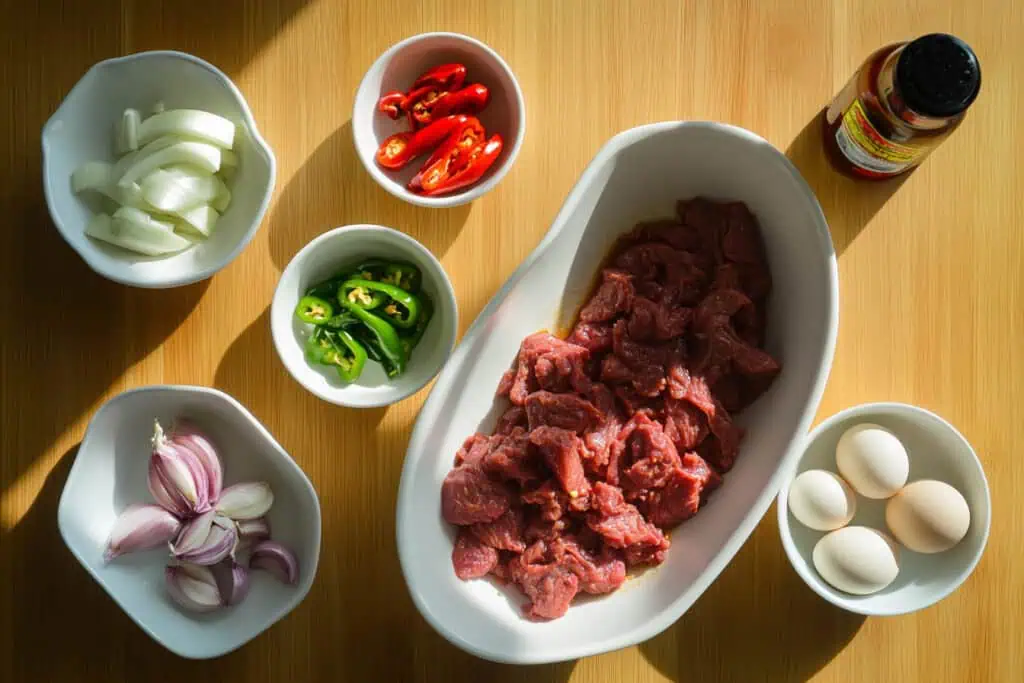
- 1 kilo beef sirloin, finely chopped
- 3 tablespoons soy sauce
- 1 tablespoon Worcestershire sauce (optional)
- 1 tablespoon cooking wine (optional)
- 1-2 white onions, minced and divided
- 5 cloves garlic, minced
- 1 can Reno liver spread
- 1 lemon or 3 pieces calamansi
- 4 pieces green chilies (siling haba), deseeded and sliced
- 1-2 pieces bird's eye chilies (siling labuyo)
- 1 tablespoon Maggi Savor
- 1 egg
- Salt and pepper to taste
- Mayonnaise (optional, for creaminess)
Equipment
- Wok or large skillet (kawali): For high-heat searing and mixing the ingredients together. The wide surface area allows for proper browning of the meat.
- Sharp knife: For mincing the beef and other ingredients. A sharp knife ensures you can chop the beef finely enough for authentic sisig texture.
- Cutting board: For safe and clean preparation of all ingredients.
- Mixing bowls: For marinating the beef and combining ingredients. Multiple bowls of different sizes help organize your preparation.
- Measuring spoons: For accurate seasoning to achieve the perfect flavor balance.
- Citrus juicer: For efficiently extracting juice from calamansi or lemon, a key flavor component.
- Sizzling plate (optional): For authentic presentation that keeps the dish hot throughout the meal.
- Wooden spoon or heat-resistant spatula: For stirring and mixing ingredients without scratching your cooking surface.
- Small bowl for cracking eggs: To prepare the egg before adding it to the dish.
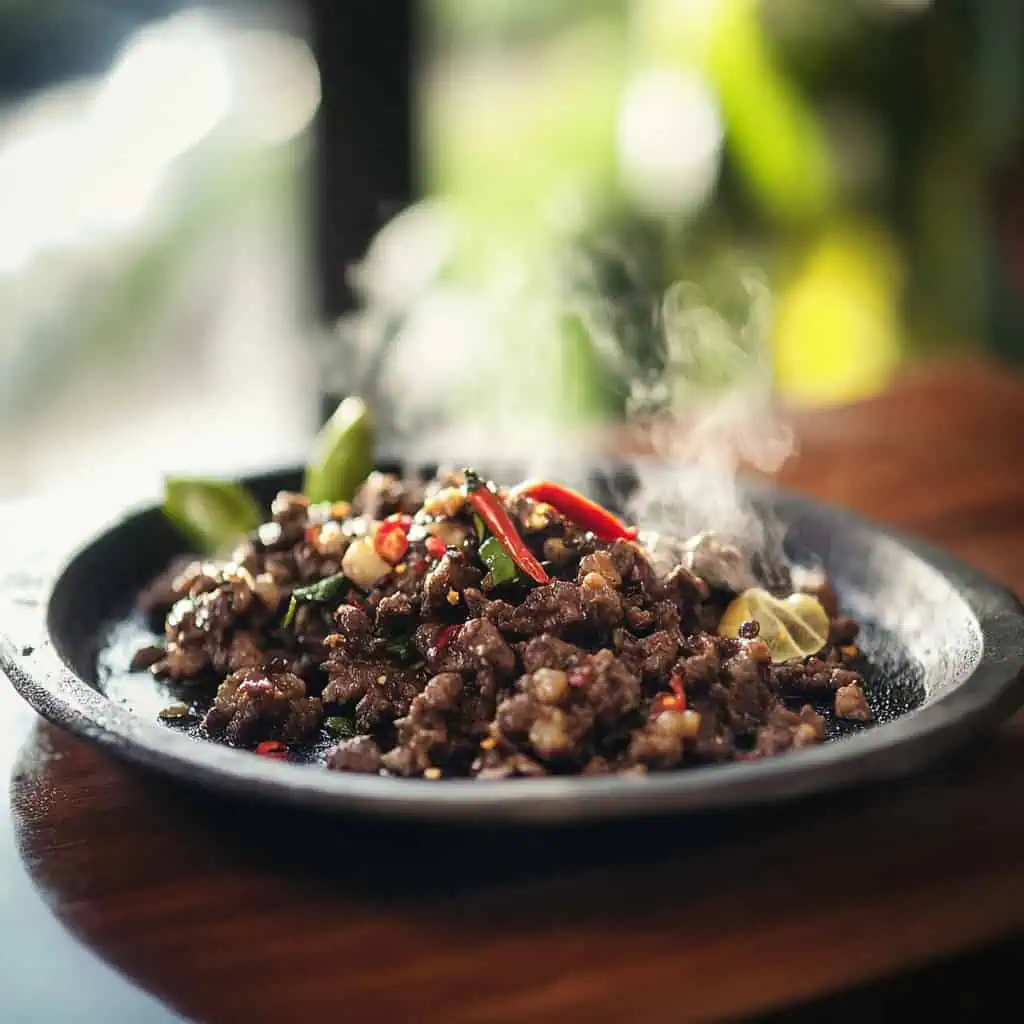
How To Make
- Place the chopped beef sirloin in a bowl and mix with soy sauce, Worcestershire sauce, and cooking wine. Let this marinate for 30 minutes at room temperature.
- Heat 2 tablespoons of cooking oil in a wok or large pan over medium heat (350°F/175°C). Add minced garlic and cook until light golden brown. Add half of your minced onions and cook until they become soft and translucent.
- Add the marinated beef to the pan. Cook for about 20 minutes, stirring occasionally, until the meat becomes tender and dark brown. Test the meat's tenderness by trying a piece – it should be easy to chew but not overcooked. Add a pinch of salt to enhance the flavor.
- Once the beef is tender, add the entire can of liver spread and mix well. Lower the heat to avoid burning. Squeeze in the juice of three calamansi (or one lemon) and cook for 5 more minutes, stirring gently.
- Add Maggi Savor for extra flavor. Mix in the sliced green chilies and the remaining minced onions. Stir everything together.
- Make a small well in the center of the beef mixture. Crack an egg into this space and let it cook for 30 seconds before mixing it thoroughly with the beef. This adds richness and helps bind everything together.
- Turn off the heat and let the sisig rest for 2-3 minutes. This allows the flavors to settle and the egg to finish cooking from the residual heat.
- Transfer your beef sisig to a serving plate or sizzling plate if you have one. Garnish with lemon or calamansi slices and chopped red chilies on top.
- If you want a creamy version, add mayonnaise now while the dish is still warm but not hot – this prevents the mayonnaise from separating.
- Serve immediately while hot, preferably with steamed rice. Place extra calamansi and chilies on the side so everyone can adjust the taste to their liking.

Tips from Lola's Kitchen
- Meat Selection: Choose beef sirloin with good marbling for the best flavor and texture. The fat content helps keep the meat juicy during cooking.
- Chopping Technique: For authentic sisig texture, chop the beef very finely but not to the point of ground meat. Ask your butcher to do this for you to save time, or partially freeze the meat before chopping to make it easier.
- Layering Flavors: Don't rush adding ingredients. Each addition builds the complex flavor profile that makes sisig special.
- Caramelization: Allow the beef to develop some browned edges during cooking – these caramelized bits add depth of flavor to the final dish.
- Temperature Control: Keep heat at medium throughout cooking to prevent the meat from becoming tough. High heat will make the beef chewy and dry.
- Taste As You Go: Adjust seasoning gradually, especially when adding liver spread and calamansi juice, as these ingredients have strong flavors.
- Egg Integration: Make sure the pan isn't too hot when adding the egg to prevent it from scrambling immediately. You want it to coat the meat lightly, not form distinct egg pieces.
- Resting Period: Let the sisig rest for 2-3 minutes before serving. This allows the flavors to meld together beautifully.
Substitutions
- Meat Option: If beef sirloin is unavailable, you can use beef chuck or even ground beef (though texture will differ). Pork shoulder or chicken thigh meat also work well.
- Liver Spread: If you can't find Reno liver spread, use any canned liver pâté or even finely chopped and sautéed chicken livers.
- Citrus Options: Fresh calamansi juice is ideal, but lime juice or a mix of lemon and orange juice can substitute in a pinch.
- Heat Level: Jalapeños can replace green chilies for a milder version, while serrano or Thai chilies can substitute for bird's eye chilies.
- Maggi Savor: Any liquid seasoning like Knorr or even additional soy sauce with a pinch of sugar can replace Maggi Savor.
- Dairy-Free: Skip the mayonnaise or use a dairy-free mayo alternative if needed.
Troubleshooting
- Tough Meat: If your beef seems tough, lower the heat and add 2-3 tablespoons of water. Cover and simmer for 5-10 more minutes until tender.
- Too Dry: Add a tablespoon each of butter and mayonnaise to introduce moisture without diluting the flavor.
- Too Salty: Balance with additional calamansi juice or a teaspoon of sugar to counteract the saltiness.
- Too Mild: If the flavor seems flat, add more calamansi juice or a splash of vinegar to brighten the taste.
- Not Spicy Enough: Add more fresh chilies or a dash of chili oil. You can also provide chili garlic sauce on the side.
- Bitter Aftertaste: This usually comes from burning the garlic. If this happens, add a teaspoon of sugar to balance the bitterness.
Storage & Reheating
- Refrigeration: Store leftovers in an airtight container for up to 3 days. The flavors often develop nicely overnight, making day-old sisig particularly flavorful.
- Freezing: Beef sisig can be frozen for up to 1 month. Cool completely before transferring to freezer-safe containers. For best texture, freeze before adding mayonnaise.
- Thawing: Thaw overnight in the refrigerator for best results.
- Reheating Methods:
- Stovetop (Preferred): Reheat in a pan over medium heat for 5-7 minutes until internal temperature reaches 165°F (74°C). Add a tablespoon of oil to prevent sticking.
- Microwave: Use 70% power in 1-minute intervals, stirring between each, until hot throughout. Add a few drops of water to prevent drying.
- Oven: Place in an oven-safe dish, cover with foil, and heat at 350°F (175°C) for 10-15 minutes.
- Refreshing: Add a squeeze of fresh calamansi and a sprinkle of chopped onions after reheating to bring back the fresh flavors.
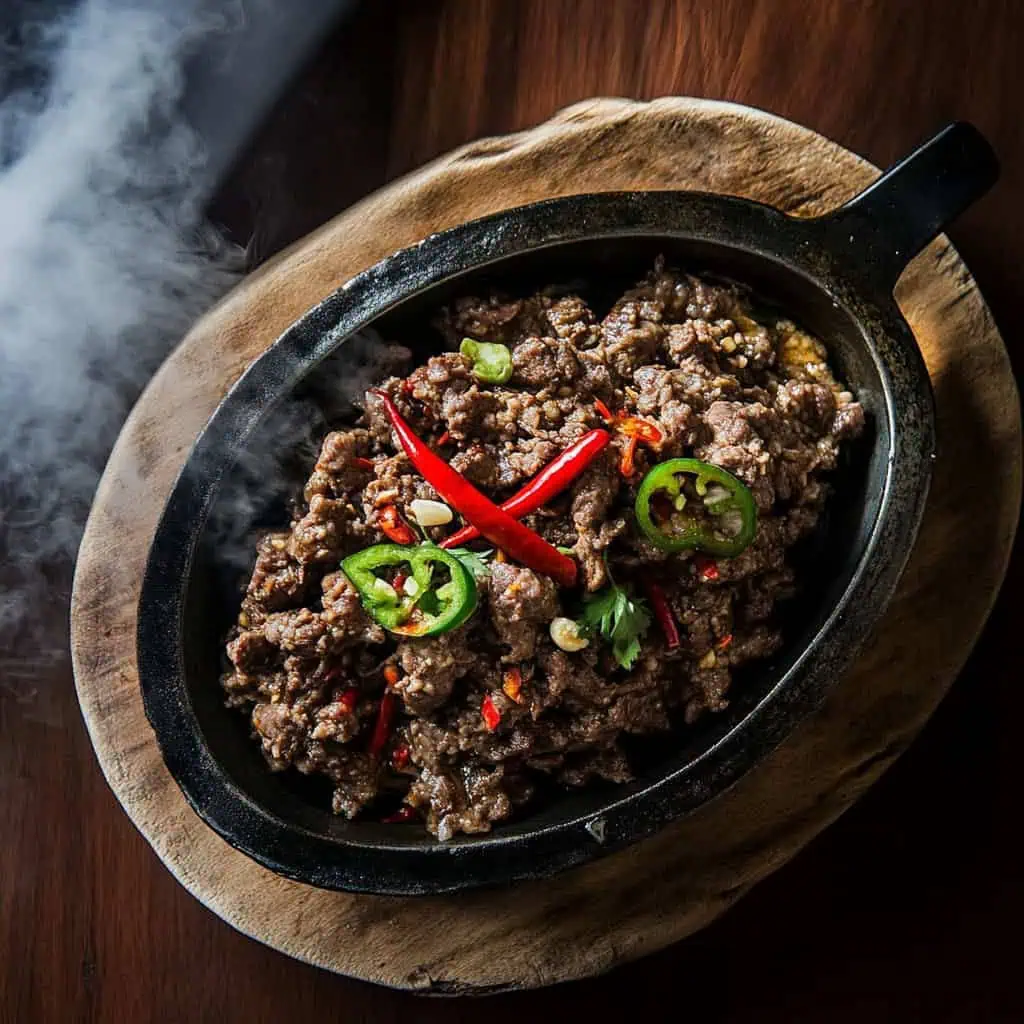
FAQ
Can I make this ahead for a party?
Yes, you can prepare up to step 7, refrigerate, and then reheat and add the egg just before serving. This makes it perfect for gatherings where you want to minimize last-minute cooking.
How spicy is this version?
This recipe is moderately spicy. You can adjust the heat level by changing the amount and type of chilies used. For a milder version, remove all seeds from the chilies or reduce the quantity.
Can I use ground beef instead of chopped beef?
Yes, ground beef will work, though the texture will be different from traditional sisig. If using ground beef, cook it until well-browned before proceeding with the recipe.
Is liver spread necessary?
While liver spread adds the authentic sisig flavor, you can omit it if you don't enjoy liver. The dish will have a different flavor profile but can still be delicious with proper seasoning adjustments.
How do I know when the beef is cooked properly?
The beef should be tender when pierced with a fork and have developed some browned edges. If you're uncertain, cut into a larger piece - it should be fully cooked with no pink inside but still juicy.
Can I make a vegetarian version of this dish?
Yes, firm tofu or mushrooms (particularly oyster or king oyster mushrooms) can substitute for beef. The key is achieving the crispy-tender texture and flavorful seasoning.
What's the best way to serve beef sisig?
Traditionally, sisig is served on a sizzling plate to maintain its crispy texture. It pairs perfectly with steamed rice and cold beer. You can also serve it as a filling for tacos or lettuce wraps for a fusion approach.
Why is my sisig too watery?
This can happen if your heat was too low during cooking. To fix this, increase heat to medium-high and cook uncovered for a few minutes to evaporate excess moisture.
Can I use other cuts of beef?
Yes, any tender cut like ribeye or tenderloin works well, though they're more expensive. Tougher cuts like chuck or brisket will need longer cooking times to become tender.
How fine should I chop the beef?
Aim for pieces about ¼ inch in size - small enough to cook quickly and create the characteristic sisig texture, but not so small that they lose their meaty bite.
Related
Looking for other recipes like this? Try these:
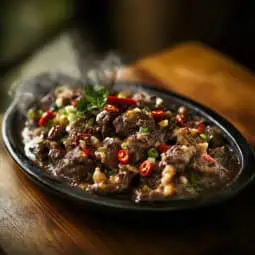
Homemade Beef Sisig Recipe
Equipment
- Wok or large skillet (kawali) For high-heat searing and mixing
- Sharp knife [Matalas na kutsilyo] For mincing ingredients
- Cutting board (Sangkalan) For prep work
- Mixing bowls (mangkok) For marinating
- Measuring spoons (panukat) For accurate seasoning
- Citrus juicer For extracting calamansi juice
- Sizzling Plate (Optional) For authentic presentation
Ingredients
For the Meat
- 1 kilo Beef Sirloin Litid ng Baka, finely chopped
- 3 tablespoons soy sauce toyo
- 1 tablespoon Worcestershire sauce optional
- 1 tablespoon cooking wine optional
For the Base
- 1-2 white onions sibuyas, minced and divided
- 5 cloves garlic bawang, minced
- 1 can Reno liver spread
- 1 lemon or 3 pieces calamansi
- 4 pieces green chilies siling haba, deseeded and sliced
- 1-2 pieces bird's eye chilies siling labuyo
- 1 tablespoon Maggi Savor
- 1 egg itlog
- Salt asin and pepper (paminta) to taste
- Mayonnaise optional, for creaminess
Instructions
- Place the chopped beef sirloin in a bowl and mix with soy sauce, Worcestershire sauce, and cooking wine. Let this marinate for 30 minutes at room temperature (manatiling nakababad sa loob ng 30 minuto).
- Heat 2 tablespoons of cooking oil in a wok or large pan over medium heat (katamtamang init, 350°F/175°C). Add minced garlic and cook until light golden brown. Add half of your minced onions and cook until they become soft and clear.
- Add the marinated beef to the pan. Cook for about 20 minutes, stirring occasionally, until the meat becomes tender and dark brown. Test the meat's tenderness by trying a piece – it should be easy to chew but not overcooked. Add a pinch of salt to enhance the flavor.
- Once the beef is tender, add the entire can of liver spread and mix well. Lower the heat to avoid burning. Squeeze in the juice of three calamansi (or one lemon) and cook for 5 more minutes, stirring gently.
- Add Maggi Savor for extra flavor. Mix in the sliced green chilies (siling haba) and the remaining minced onions. Stir everything together.
- Make a small well in the center of the beef mixture. Crack an egg into this space and let it cook for 30 seconds before mixing it thoroughly with the beef. This adds richness and helps bind everything together.
- Turn off the heat and let the sisig rest for 2-3 minutes. This allows the flavors to settle and the egg to finish cooking from the residual heat.
- Transfer your beef sisig to a serving plate or sizzling plate if you have one. Garnish with lemon or calamansi slices and chopped red chilies on top.
- If you want a creamy version, add mayonnaise now while the dish is still warm but not hot – this prevents the mayonnaise from separating.
- Serve immediately while hot, preferably with steamed rice. Place extra calamansi and chilies on the side so everyone can adjust the taste to their liking.
- Remember: Keep your heat at medium throughout cooking (hindi masyadong mataas) to prevent the meat from becoming tough, and taste as you go to adjust the seasoning to your preference.
Tips from Lola's Kitchen
- Meat Preparation: Ask your butcher to chop the beef extra fine (tinadtad) for authentic texture
- Temperature Control: Keep heat moderate to prevent tough meat
- Texture Secret: The egg helps bind ingredients while adding richness
- Flavor Building: Add liver spread gradually to control intensity
Nutrition
The Story Behind Homemade Beef Sisig
Every plate of sisig tells a story of Filipino resourcefulness and creativity. While today's beef sisig offers a modern take on this beloved dish, the original sisig has humble beginnings in Angeles City, Pampanga – the culinary capital of the Philippines. Back in the 1970s, Lucia "Aling Lucing" Cunanan transformed what was once a simple dish of boiled pig face and ears into the sizzling sensation we know today.
The word "sisig" actually comes from an ancient Kapampangan word "sisigan," which means "to make something sour." Originally, it referred to a salad of green papaya and pig ears seasoned with vinegar and calamansi – a far cry from the sizzling plate we crave today. The game-changing moment came when Aling Lucing started chopping up pig's face, adding chicken liver, and serving it on a hot plate, creating that signature sisig sizzle that's now famous worldwide.
The evolution of sisig shows how Filipino cuisine keeps adapting while staying true to its roots. When Clark Air Base was still active in Angeles City, local cooks would get discarded pig heads from the base commissary and turn them into this mouthwatering dish. This creativity born from necessity became a source of pride for Kapampangan cuisine, proving that great food can come from humble ingredients.
Today's beef sisig represents the next chapter in this dish's story. As more people look for easier ways to enjoy this Filipino favorite, beef sisig has emerged as a delicious alternative that's more accessible to home cooks. It keeps the essential elements that make sisig irresistible – that perfect mix of tangy, savory, and spicy flavors, the satisfying sizzle, and the way it brings people together – while making it easier to prepare in any kitchen.
Sisig's journey from simple bar food to internationally recognized Filipino dish shows its incredible appeal. Whether it's the traditional pig face version in Pampanga, this modern beef adaptation, or even meat-free variations popping up in restaurants worldwide, sisig continues to win hearts and palates. Anthony Bourdain once called sisig "perfectly positioned to win the hearts and minds of the world," and looking at how it's evolved and adapted while keeping its soul intact, it's easy to see why.
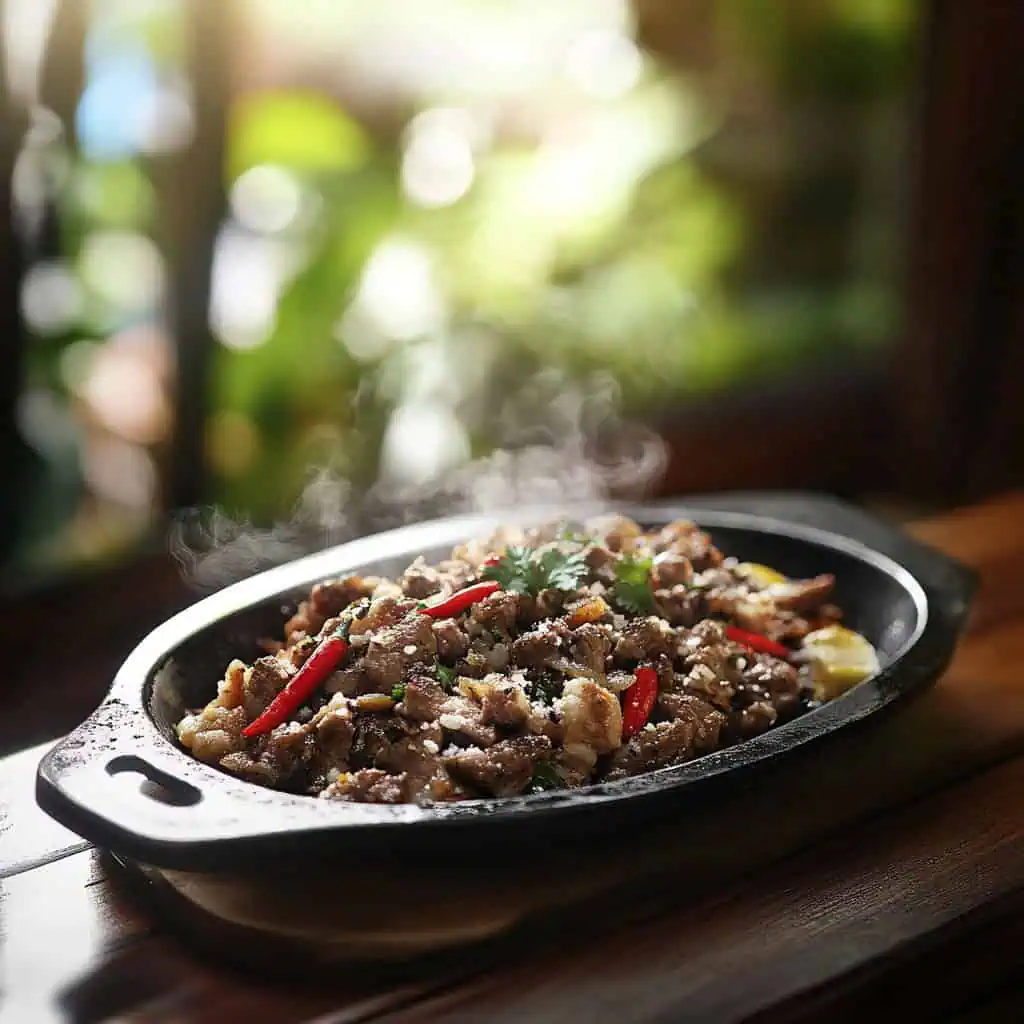


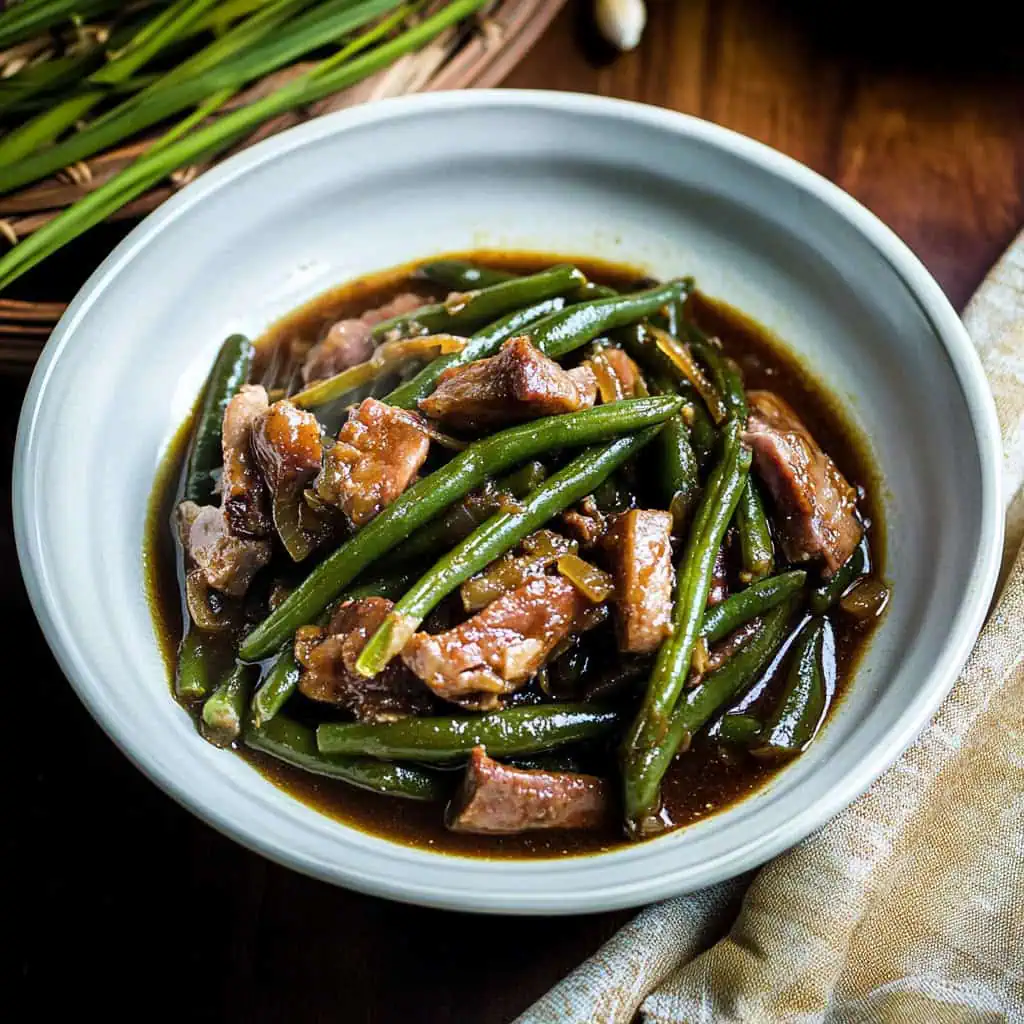

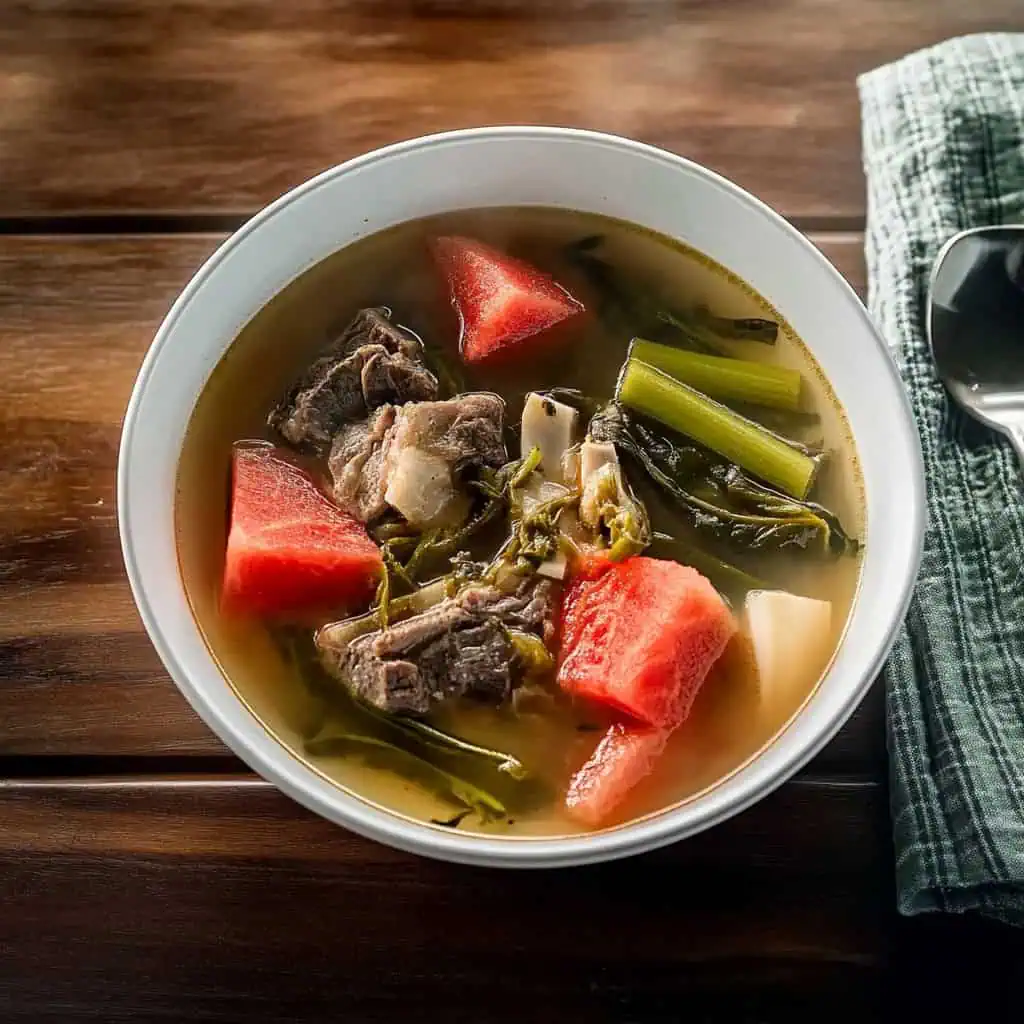

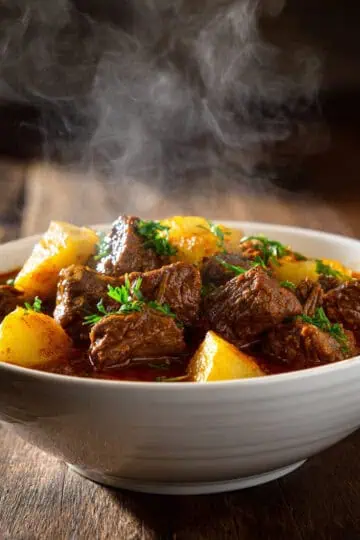


Comments
No Comments